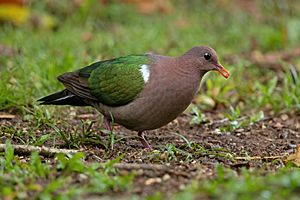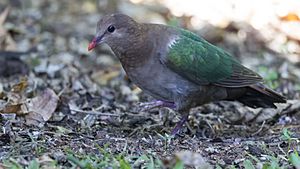Pacific emerald dove facts for kids
Quick facts for kids Pacific emerald dove |
|
|---|---|
 |
|
| Conservation status | |
| Scientific classification | |
| Genus: |
Chalcophaps
|
| Species: |
longirostris
|
| Subspecies | |
|
See text |
|
The Pacific emerald dove, also called the brown-capped emerald dove, is a beautiful pigeon. Its scientific name is Chalcophaps longirostris. These doves live in warm, tropical places. You can find them from Indonesia all the way to northern and eastern Australia. They are "resident breeding birds," which means they live and have their babies in the same areas all year round. This dove used to be considered the same species as the common emerald dove.
Contents
What They Look Like
The Pacific emerald dove is a strong, medium-sized pigeon. It is usually about 23 to 28 centimeters (9 to 11 inches) long. Its back and wings are a bright, shiny emerald green. The feathers used for flying and its tail are blackish. When it flies, you can see wide black and white stripes on its lower back.
The dove's head and chest are a dark pinkish-red color. This color fades to a grayish shade on its lower belly. Its eyes are dark brown, and its beak is a bright red. Its legs and feet are a reddish-brown color.
You can tell the difference between male and female doves. The male has a white patch on the edge of its shoulders and a gray cap on its head. The female does not have these features. Females often look a bit browner and have a gray mark on their shoulder. Young doves look like females but have brown wavy patterns on their body and wing feathers.
Where They Live and How They Behave
This dove is common in rainforests and other thick, wet woodlands. You can also find them on farms, in gardens, in mangroves, and along coastal heaths.
Pacific emerald doves usually live alone, in pairs, or in small groups. They spend a lot of time on the ground. They often look for fallen fruit there. They do not spend much time in trees, except when they are resting. They eat seeds and fruit from many different plants. These birds are generally calm and easy to approach.
Their flight is very fast and goes straight. They flap their wings regularly and sometimes give a sharp flick, which is common for pigeons. They often fly low between thick forest areas. However, if they are disturbed, they will often walk away instead of flying. They are very good at flying through dense forests. When they fly, you can see their light brown underwings and the chestnut color of their flight feathers.
Reproduction and Life Cycle
Pacific emerald doves build a simple nest made of sticks. They build it in a tree, usually up to five meters (about 16 feet) high. The female lays two cream-colored eggs.
In southeastern Australia, they tend to have their babies in the spring or early summer. In northern Australia, breeding usually happens late in the dry season.
Calls and Courtship
The call of the Pacific emerald dove is a soft, low cooing sound. It usually has about six to seven coos. The call starts quietly and then gets louder. They also make a nasal "hoo-hoo-hoon" sound. During courtship, the male doves perform a special bobbing dance to attract a mate.
Subspecies
The Pacific emerald dove has four different types, called subspecies:
- C. l. timorensis (found in the eastern Lesser Sunda Islands)
- C. l. longirostris (found in northern Australia)
- C. l. rogersi (found in eastern Australia, Lord Howe and Norfolk Islands, and New Guinea)
- C. l. sandwichensis (found in the Santa Cruz and Banks Islands, Vanuatu, and New Caledonia)
See also
 In Spanish: Palomita esmeralda cabeciparda para niños
In Spanish: Palomita esmeralda cabeciparda para niños




